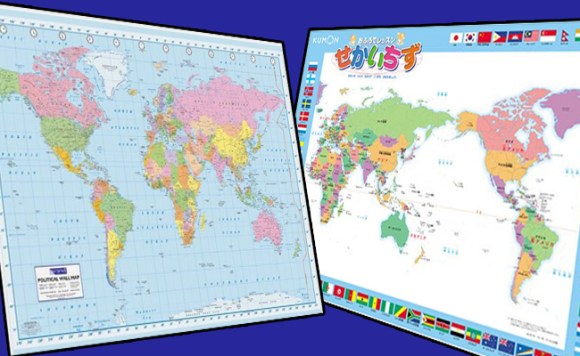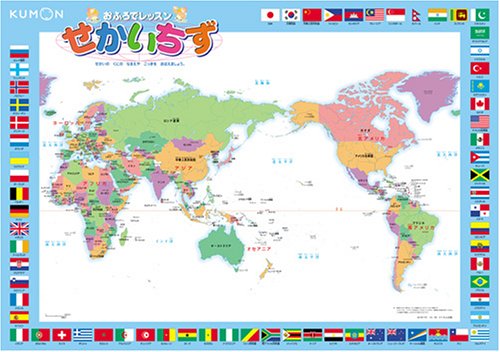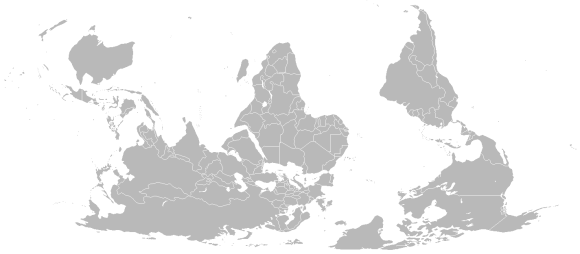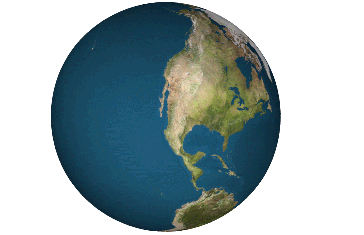
Depending on what part of the world you live in, one of these maps will look right at home while the other might seem kind of off. However, given the overall dominance of the Euro-centric map, the other one is more likely to give an uncomfortable feeling to a greater number of people.
While both are currently in use in different countries, is it possible that one map is more valid than another?
A discussion broke out on the international imageboard 4chan over Pacific-centric maps. Although it was misguidedly introduced as only a “Japanese-made map” surprisingly a fair number of people from various countries came to its defense.
USA: Japanese people use a world map with Japan in the center… What do you think about that?
Canada: Holy crap! Look at all that wasted space in the middle where the Pacific Ocean is.
Italy: It makes more sense than I expected.
France: It “makes sense” that Greenland is split into two?
Finland: Good luck finding anyone who’ll care that Greenland is split.
Argentina: It is useful, putting your own country in the center of the map.
USA: Silly Japanese, don’t they know America is the center of the world?
UK: It’s actually kind of cool. You can better see how homo sapiens evolved and spread across the world from left to right.
Italy: Seeing Italy on the outer parts of the world gives me a strange feeling…
Australia: Australian people use the same map.
Thanks to the comment out of Australia we could see that this map is not exclusive to Japan but to other countries in the Eastern part of Asia as well.
And while we’re on the topic of Australia, I have an open request for the whole continent: Would you please stop telling Japanese tourists that you use a version of the world map with Australia on top? I have met a surprising number of people in Japan who are fully convinced everyone in Australia uses a south-up map.
Anyway, the Pacific-centered map certainly has some benefits in terms of anthropology. It also disrupts the barren tundra of Greenland instead of the numerous populated islands of the Pacific. It’s also more in keeping with the tectonic plates.
On the other hand, the Euro/Afro-centric map has the benefit of being more in line with the time zones. In addition, straying from it would screw-up various common English terms. North and South America would become the Far East and the Middle East would become the Mid-West.
In the end though, it doesn’t really matter as the boundaries of maps are completely arbitrary on a round world. And with the advent of geographic information systems like Google Maps the world can look any way you want it to at any time.
Not to mention that Mercator projection maps are for third-graders and USA Today infographics. If you want a truly distortion-free look at the Earth in 2-D, go Dymaxion map or go home.
Source: Kaigai No Bankoku Hannoki (Japanese)
World Maps: Amazon – 1, 2
South-up map: Wikipedia – CaseyPenk
Dymaxion map: Wikipedia – Chris Rywalt




 One man’s epic journey around the world… on a unicycle
One man’s epic journey around the world… on a unicycle Japanese Guy Follows Dream of Travelling World and Taking Pictures of Beautiful Women (But Needs Our Help)
Japanese Guy Follows Dream of Travelling World and Taking Pictures of Beautiful Women (But Needs Our Help) Ranking of Taxi Fares Around the World – Japanese Passengers Getting Hosed, Even More So Next Year
Ranking of Taxi Fares Around the World – Japanese Passengers Getting Hosed, Even More So Next Year Which 15 countries have the least violent armed forces in the world?
Which 15 countries have the least violent armed forces in the world? Is it rude to sing along at concerts in Japan? We ask a pro musician for his take
Is it rude to sing along at concerts in Japan? We ask a pro musician for his take Lacquerware supplier to emperor of Japan and Pokémon team up for new tableware
Lacquerware supplier to emperor of Japan and Pokémon team up for new tableware Starbucks Japan releases new zodiac chilled cup drink for 2026
Starbucks Japan releases new zodiac chilled cup drink for 2026 Disillusionment at Tsukiji’s tourist-target prices led us to a great ramen restaurant in Tokyo
Disillusionment at Tsukiji’s tourist-target prices led us to a great ramen restaurant in Tokyo Japan may add Japanese language proficiency, lifestyle classes to permanent foreign resident requirements
Japan may add Japanese language proficiency, lifestyle classes to permanent foreign resident requirements Cup Noodle pouch satisfies our never-ending need for instant ramen
Cup Noodle pouch satisfies our never-ending need for instant ramen Want an easy way to eat Christmas turkey in Japan? Mr. Sato finds it, tries turkey for first time
Want an easy way to eat Christmas turkey in Japan? Mr. Sato finds it, tries turkey for first time Cosplay makeup hack: How to bring anime sparkle to your eyes
Cosplay makeup hack: How to bring anime sparkle to your eyes Visiting the Kikyoya Shingen Mochi theme park takes some planning–but it’s a stop worth making!
Visiting the Kikyoya Shingen Mochi theme park takes some planning–but it’s a stop worth making! Dragon Quest Burgers and Slime drinks are coming to McDonald’s Japan【Video】
Dragon Quest Burgers and Slime drinks are coming to McDonald’s Japan【Video】 7-Eleven Japan starts new temporary luggage storage service in over 300 branches
7-Eleven Japan starts new temporary luggage storage service in over 300 branches Starbucks teams up with 166-year-old Kyoto doll maker for Year of the Horse decorations【Photos】
Starbucks teams up with 166-year-old Kyoto doll maker for Year of the Horse decorations【Photos】 Tokyo’s Tsukiji sushi neighborhood asks tour groups to stay away for the rest of the month
Tokyo’s Tsukiji sushi neighborhood asks tour groups to stay away for the rest of the month Street Fighter Hadouken Churros to be launched and eaten in Tokyo, Okami pudding on offer too
Street Fighter Hadouken Churros to be launched and eaten in Tokyo, Okami pudding on offer too Is this the most relaxing Starbucks in Japan?
Is this the most relaxing Starbucks in Japan? Starbucks on a Shinkansen bullet train platform: 6 tips for using the automated store in Japan
Starbucks on a Shinkansen bullet train platform: 6 tips for using the automated store in Japan Large amount of supposed human organs left in Osaka marketplace
Large amount of supposed human organs left in Osaka marketplace Japan’s human washing machines will go on sale to general public, demos to be held in Tokyo
Japan’s human washing machines will go on sale to general public, demos to be held in Tokyo Japanese train company is letting fans buy its actual ticket gates for their homes
Japanese train company is letting fans buy its actual ticket gates for their homes Tokyo considering law requiring more trash cans following litter increase in heavily touristed area
Tokyo considering law requiring more trash cans following litter increase in heavily touristed area Is China’s don’t-go-to-Japan warning affecting tourist crowds in Tokyo’s Asakusa neighborhood?
Is China’s don’t-go-to-Japan warning affecting tourist crowds in Tokyo’s Asakusa neighborhood? Nintendo’s Kirby now delivering orders at Kura Sushi restaurants, but not in Japan
Nintendo’s Kirby now delivering orders at Kura Sushi restaurants, but not in Japan Tokyo event lets you travel back in time, for free, to celebrate 100 years since Showa era start
Tokyo event lets you travel back in time, for free, to celebrate 100 years since Showa era start Survey asks foreign tourists what bothered them in Japan, more than half gave same answer
Survey asks foreign tourists what bothered them in Japan, more than half gave same answer Japan’s deadliest food claims more victims, but why do people keep eating it for New Year’s?
Japan’s deadliest food claims more victims, but why do people keep eating it for New Year’s? We deeply regret going into this tunnel on our walk in the mountains of Japan
We deeply regret going into this tunnel on our walk in the mountains of Japan Studio Ghibli releases Kodama forest spirits from Princess Mononoke to light up your home
Studio Ghibli releases Kodama forest spirits from Princess Mononoke to light up your home Major Japanese hotel chain says reservations via overseas booking sites may not be valid
Major Japanese hotel chain says reservations via overseas booking sites may not be valid Put sesame oil in your coffee? Japanese maker says it’s the best way to start your day【Taste test】
Put sesame oil in your coffee? Japanese maker says it’s the best way to start your day【Taste test】 The top 10 annoying foreign tourist behaviors on trains, as chosen by Japanese people【Survey】
The top 10 annoying foreign tourist behaviors on trains, as chosen by Japanese people【Survey】 No more using real katana for tourism activities, Japan’s National Police Agency says
No more using real katana for tourism activities, Japan’s National Police Agency says Starbucks Japan reveals new sakura drinkware collection, inspired by evening cherry blossoms
Starbucks Japan reveals new sakura drinkware collection, inspired by evening cherry blossoms Shikoku Island holds world landmark lookalike photography contest judged by AI
Shikoku Island holds world landmark lookalike photography contest judged by AI Around the world in 22 upside-down houses 【Photos】
Around the world in 22 upside-down houses 【Photos】
Leave a Reply